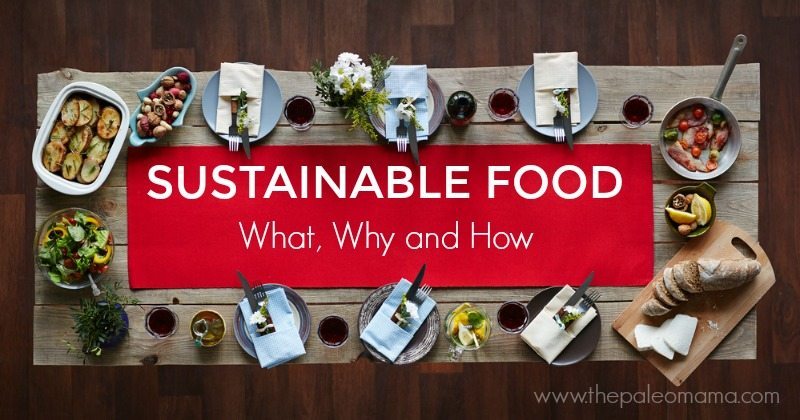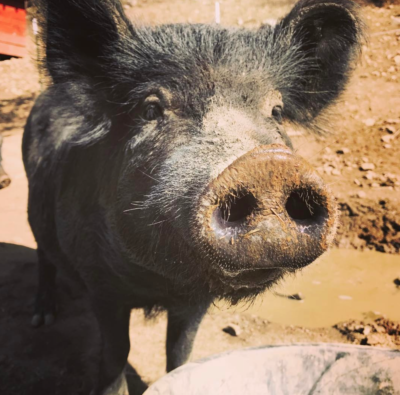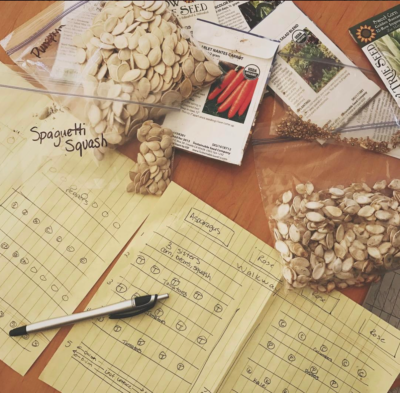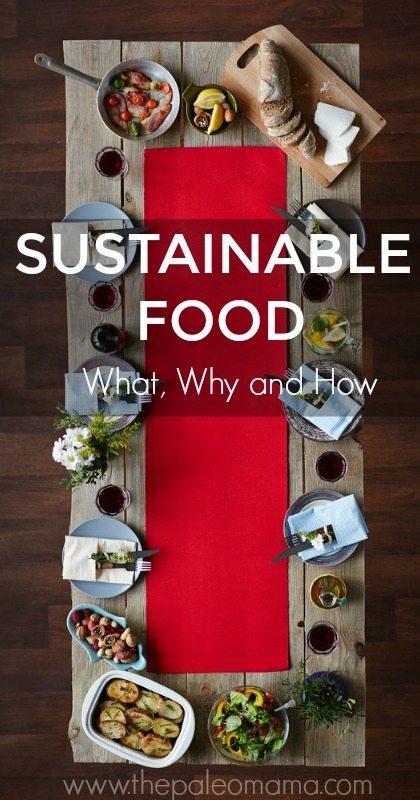
One of this year’s hottest trends in food is changing our eating habits to a more sustainable food. In the last couple years we’ve seen huge corporations making recalls of unsafe packaged foods, like:
- The recall of Blue Bell’s entire product line, which could be tainted with the Listeria bacteria.
- Tyson’s recall of more than 132,000 pounds of fully cooked chicken nuggets that could have been contaminated with hard plastic.
- Costco’s recall of its popular chicken salad because of the e.coli bacteria in it.
- Lunchables ham and cracker stackables recall due to mislabeled allergens.
- Target and Walmart’s recall of frozen veggies because of a potential listeria contamination.
With good reason, consumers have begun to understand the relationship between the food they eat and how it was produced. I want to look more closely at ways we can be certain that the food we choose to eat is of the highest quality. We want to eat sustainable food, which has been defined as:
“I like to say that sustainable agriculture is a production system that’s good for the environment and for people, that’s humane to animals and to food and farm workers, that supports thriving rural and urban communities. In other words, it’s the production of food, fiber, or other plant or animal products using techniques that protect the environment, public health, human communities, and animal welfare. It’s a way of food production that generates abundance while ensuring future generations can do the same.”[1]
To put it more simply…we want to eat food that we can vouch for. We want to know who grew it, that it grew in organic soil, with natural, safe, organic practices. We want it to be economical, safe, healthy, and freshly harvested when it reaches us. And we want it to promote better physical health for us and better ecological health for our land.
I want to look closer in this blog post at ways we can begin to give our families a more sustainable diet.
Take care of your body. It’s the only place you have to live.
Why Eat Sustainable Food?
 You may wonder why learning to eat more sustainably really matters. There seems to be so many things we’ve done already to eat healthier food. We’ve tried to limit the amount of processed foods we buy so we can eliminate toxins, chemicals, and GMOs from our diets. We started concentrating on shopping the foods around the outside shelves in our supermarkets, rather than the inside aisles where heavily processed foods are found. We’ve begun to concentrate on buying organic foods whenever possible, even though they are often more expensive. We’ve even started buying some of our food at local farmer’s markets and food co-ops. Is the even deeper step into sustainable eating really all that important?
You may wonder why learning to eat more sustainably really matters. There seems to be so many things we’ve done already to eat healthier food. We’ve tried to limit the amount of processed foods we buy so we can eliminate toxins, chemicals, and GMOs from our diets. We started concentrating on shopping the foods around the outside shelves in our supermarkets, rather than the inside aisles where heavily processed foods are found. We’ve begun to concentrate on buying organic foods whenever possible, even though they are often more expensive. We’ve even started buying some of our food at local farmer’s markets and food co-ops. Is the even deeper step into sustainable eating really all that important?
It is, and here is why. Sustainable eating is about more than just ourselves—it is also about the foods that are going to be available to our children and grandchildren, about the earth, and its ability to produce safe, healthy, food for the generations to come.
- Most of the food in our grocery stores is the product of unsustainable farming. It is ever more increasingly destroying soil, contaminating water, and causing disease outbreaks.
- Animal products are raised purely for profit, without regard for the proper care and health of those animals.
- Our farmers are being paid by the government to monocrop—which is growing a single crop year after year on the same land, which damages the soil, depleting it of nutrients and requiring it to be heavily dependent on pesticides and artificial fertilizers.
- Food is transported great distances, which uses large amounts of non-renewable resources, and greatly reduces the freshness of our food by the time it reaches us.
How Do We Begin Eating Sustainable Food?

So, how do we take that deeper step—move toward a more sustainable diet for our families? Here are ten steps you can take to eat healthier, shop smarter, and find great tasting sustainable food in your area:
- Educate yourself—do some research, talk to others, spend a little time learning about the food you are eating.
- Shop sustainable—don’t try to change everything overnight. Start with one item that you commit to buying organically, or at a local farmer’s market. (Find local sources here.)
- Ask questions—were pesticides used? What were the animals fed? How were they raised? What fertilizers were used on the plants?
- Eat seasonal—buy locally grown fruits and vegetables when they are in season.
- Grow your own—nothing tastes better than food you grow yourself, whether it be herbs on a windowsill, pots of food on a sunny patio, or an entire backyard garden.
- Cook—relearn (or learn) the joy of cooking. You can find great recipes online.
- Take back the tap—bottled water causes a lot of problems, from plastic leaching into the water to major environmental problems. Pledge to reduce your consumption of bottled water.
- Spread the word—help to educate others about the problems with industrial agriculture and the benefits of sustainable food.
- Enjoy—fresh, healthy, sustainable food from your local farmer simply tastes better.[2]
Like so many things in life, eating sustainably starts with baby steps. You don’t have to change everything all at once. When you start to feel overwhelmed, focus on just one or two things. For example, if you can’t always afford to buy sustainably raised meat, find ways to serve meat less often. Plan your weekly meals in advance, and shop with a list so you don’t overbuy. Begin to cook in bulk and freeze the leftovers for lunches or when you are short on time. Just start!

Help Me Find Time for Meal Preparation
In our fast-paced modern lives we seem to have less and less time for planning and cooking meals at home. For many, a steady diet of fast foods or prepared processed grocery store foods has become a way of life.
Don’t let time be the main reason you don’t eat more sustainably. There are many ways we can learn to simplify meal preparation. Some of these include.[3]
- Sign up for Real Plans – It’s my favorite meal planning website and you can customize your meal plan to what you like and don’t like. Click here to read more about Real Plans.
- Make one-pot meals—one-pot cooking methods are simple and healthy. They can be steamed, sautéed, stewed or baked. Here’s my favorite book on one-pot meals.
- Crock pot cooking—slow cookers can cook your meals for you while you are away from home during the day. There is little upfront preparation, and the end result gives you healthy, tasty food.
- Pressure cooker meals—one of the best kitchen appliance inventions for me has been my Instant Pot. Foods cook in a fraction of the time, and they are a healthier way to cook because water-soluble vitamins and minerals are retained better than in regular pot. This is my favorite Instant Pot cookbook.
- Freezer-based meals—a well-stocked and managed freezer will help you plan delicious, balanced meals efficiently. You can take better advantage of special prices on food throughout the year, which allows you to stretch your budget. And one weekend of cooking can give you enough meals for nearly a whole month. There are many online sites to help you plan some freezer meals, including Once a Month meals!
With just a little bit of effort, you will soon be a pro at providing your family with healthy, delicious meals made the sustainable way!
This magical, marvelous food on our plate, this sustenance we absorb, has a story to tell. It has a journey. It leaves a footprint. It leaves a legacy. To eat with reckless abandon, without conscience, without knowledge; folks, this ain’t normal.
—Joel Salatin
Can You Share a Couple Recipes?
I’m so glad you asked, because I love being able to pass on the recipes that have enabled me to provide our family with healthy, delicious, fresh and sustainable meals. We are so privileged to be able to homestead and grow and raise so much of our own food supplies. Let me share a couple recipes that you can use with your own family’s move to a more sustainable diet. These recipes are not so much specific ingredients as they are taking advantage of locally available fresh ingredients that can make a very tasty meal.
Breakfast Frittata
We’ve become experts in my home of creating delicious, healthy breakfast frittatas from whatever we have freshly harvested from our own gardens or from the local farmer’s market in our neighborhood. Here are some guidelines for you to get creating your own fantastic breakfast frittatas.
Ingredients
Here are some ideas for fresh ingredients you may be able to use
- 4-5 fresh, pastured eggs (our free range chickens keep us supplied with delicious, fresh eggs every day.)
- ½ cup or so of whatever herbs are fresh in your garden (parsley, basil, chives, mint, thyme, etc.)
- Fresh bacon or sausage (found at your local farmer’s markets and supplied by organic farmers in your area who are raising pastured pigs)
- 2-3 handfuls of freshly harvested spinach, kale, or other greens
- 1-2 cups of freshly harvested veggies (peppers, tomatoes, onions, broccoli, mushrooms)
- Your choice of shredded cheese (I often have my homemade cheeses to use)
- 1 Tbsp or so of farm-fresh butter (Holly, my Jersey cow, helps us out here)
- ½ cup of fresh cream if needed
- Sea salt and freshly ground pepper
Directions
Preheat your oven to 350 degrees. Melt your butter in a large pan and add your veggies, salt and pepper. Cook for about 5 minutes. Whisk your eggs together with your cream, and stir in about half of your shredded cheese. Spread your sautéed veggies in your pre-greased pan (we love bacon fat for this). Pour your egg mixture over the top and bake for about 30 minutes. Just before serving, sprinkle the remaining cheese on top, and broil if desired until browned. ENJOY!
Slow Cooker Chicken Vegetable Soup
Fresh chicken vegetable soup make with sustainable veggies and farm-fresh chicken is another easy meal to create for your family. If you have leftover turkey from your Thanksgiving dinner, it is even better! Here’s some ideas to get you cooking.
Ingredients
Here are some suggested ingredients for your soup
- Freshly made chicken bone broth (follow my recipe here)
- Cut-up chicken (if desired, use an antibiotic-free rotissiere chicken from a grocery store)
- 2-3 diced carrots
- 2-3 diced potatoes
- 2-3 stalks of celery
- Diced onion
- Diced tomatoes
- Fresh kale or spinach
- 2-3 minced garlic cloves
- Sea salt and freshly ground pepper
Directions
Add all your ingredients except greens to a large slow cooker, and cook on low for 6-8 hours, or high for 3-4 hours. Add the greens in for the last 5 minutes of cooking. Serve hot. This delicious home-made soup can be frozen in single-serve servings if desired.
Grilled Grass-fed Meats
Our family is fortunate enough to have the magic twosome for healthy grilling—our own harvested grassfed beef and poultry, and our own grillmaster, my husband, Frank. We have had so many delicious grilled meats since he got his own Green Egg for Christmas a couple years ago. Grilling is one of the best ways to cook your fresh, grass-fed meats. Just remember these simple rules:
- Be careful not to overcook your meet. Grass-fed meat requires less time to grill than grain-fed meat.
- It is best grilled medium rare to medium.
- Check the internal temperature in the thickest part. At 145-155 degrees farenheit it will be medium-rare to medium.
- Let the meat rest a few minutes after grilling to redistribute the juices inside.
- Don’t forget that freshly harvested vegetables are also so tasty when grilled. Just brush them with oil, sprinkle with salt and pepper, and grill.
Get Started
So, what was that reason why you haven’t started moving your family toward a more sustainable diet? Eating this way may take a bit more effort, but the rewards—for your family and their future—are just too big to pass up.
I love and trust, Real Plans meal planning service. You can pick what kind of diet you eat (traditional, paleo, vegetarian, etc) and the meal plans are seasonal and use real food ingredients. CLICK HERE to learn more about Real Plans!
He who knows what sweets and virtues are in the ground, the waters, the plants, the heavens, and how to come at these enchantments, is the rich and royal man.
—Ralph Waldo Emerson
Sources
- https://www.simplebites.net/10-tips-for-sustainable-eating/
- https://www.sustainabletable.org/568/do-you-have-to-eat-100-local-sustainable-and-organic
- https://eartheasy.com/eat_simplify_meal_preparation.html
- https://www.simplebites.net/10-tips-for-sustainable-eating/
[1] Anna Lappe, author and sustainable food advocate, in: https://www.marthastewart.com/1076115/beyond-organic-just-what-sustainable-food
[2] Information included in these ten steps adapted from: https://www.gracelinks.org/media/pdf/ten_steps_to_eating_sustainable_ho_20090416.pdf
[3] This section adapted from: https://eartheasy.com/eat_simplify_meal_preparation.html

Leave a Reply